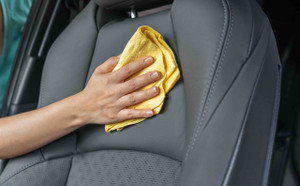Common ways to clean leather car seats
By Kijiji Autos
geargodz - stock.adobe.com
For many people, leather seats signify luxury. But they do require a certain amount of maintenance. Neglected leather car seats tend to look pretty sad with all their cracks, scratches and stains. Plus, dirty and damaged seats could impact the value of your vehicle. On the other hand, a well-maintained leather interior can keep your car looking fresh for many years.
Looking for your next car? For advice on how to clean leather seats in a car, Follow these five steps to clean, condition and protect your leather seats:
1. Vacuum the seats
Before you wash car seats, it's important to vacuum and dust them. Removing loose dirt, crumbs and debris helps prevent damage to the leather. Choose a vacuum nozzle that can get into tight crevices, but be sure to use a gentle touch to avoid scratching the leather. After vacuuming, wipe the seats with a soft dry cloth to remove any leftover dust. It's a good idea to dust and vacuum your leather interior regularly.
2. Apply a leather cleaner
Now that your seats are dust-free, it's time to clean them. Choose a high-quality, non-toxic leather cleaner. Avoid cleaners containing bleach or ammonia, as these could damage leather. When using a cleaning product for the first time, we recommend reviewing package instructions and warnings before applying it to your leather seats. You may want to do a spot test in an inconspicuous area first.
Apply a small amount of the leather cleaner onto a clean soft cloth. Microfibre is one of the most common choices. Then gently rub your seats with the dampened cloth, a small section at a time. You can reapply cleaner to the cloth as needed, but make sure not to saturate it. Never spray or pour a cleaning solution directly onto your leather seats, especially if they are perforated. You want to avoid moisture getting down into the seats, as this could contribute to cause mould or mildew.
3. Remove stains from car seats
After one application of the leather cleaner, you may notice some dirt or stains remaining. For these difficult spots, you may need to scrub a little harder. If a microfibre cloth isn't cutting it, try using a soft-bristled brush. Apply some of the cleaning solution to the brush, and then gently scrub at the trouble areas. Be careful not to scrub too hard—and never scrub perforated leather. To avoid future stains, always promptly and thoroughly blot any spills.
4. Dry thoroughly
Once your seats are clean and stain-free, it's important to dry them thoroughly. Take a clean dry cloth and wipe the surface of the seats, making sure that any excess cleaning solution is removed or absorbed. This simple but important step helps to prevent staining, cracking and mildew.
5. Apply a leather conditioner
Over time, leather loses some of its natural oils, making it less flexible and prone to cracking. To help replenish those oils, you could use a leather conditioner on your car seats a few times a year. Choose a high-quality conditioner, and try to avoid products containing petroleum or waxes. Apply the leather conditioner to clean dry seats with a soft cloth, allow to absorb for the time recommended on the package, then wipe dry. This will help protect your seats from sun damage, fading and cracking.
Looking to upgrade to a car with leather seats? Kijiji Autos offers a huge selection of new, used and dealer-certified vehicles for sale in your area and across Canada.
Easily find your next ride on Kijiji Autos
Search nowCosts of Installing an Electric Car (EV) Charging Station in Canada
Installing a home EV charger can come with additional fees beyond purchase and installation. Here's a list of factors that can affect the price of a home EV charger.Toronto to Calgary Road Trip: Routes & Tips
Planning on driving from Toronto to Calgary? Here are some routes and tips to help you along the way.7 items you can fit in an SUV: TVs, mattresses and more
Discover seven common items that fit in an SUV below.Flat Tire vs Blowout: What's the Difference & What Should You Do?
The main difference between a flat tire and a blowout is that a blowout often feels like an explosion has occurred underneath your vehicle. Blowouts can cause sudden and drastic changes to the handling of your vehicle and can lead to minor or even serious accidents.Tips to help protect your vehicle and budget for car repairs
When shopping for your next vehicle, it's always a good idea to keep hidden costs in mind. Before you buy, let's look at how much it can cost to maintain a car in Canada, how much you could budget for annual maintenance and repairs, and how to help protect your car against damage and depreciationWhat is the value of undercoat protection on your vehicle?
When you buy a new vehicle, protecting it so that it lasts as long as possible is definitely top of mind, whether that's through security upgrades or an extra coat of paint. But how often do you consider the care and safety of your vehicle’s undercarriage?The top three best paint protection options for your vehicle
Buying a new vehicle is a great experience. Nothing beats hitting the road in a car you bought fresh off the lot. However, as fun as it is to finally get behind the wheel of your new ride, it's important to take your time through the process.Financial guide: post-pandemic car shopping and gas price hacks
With populations locked down and international borders closed the global supply chain has been disrupted on a massive scale, pushing up inflation around the world and raising the cost of everything that people need to get back to normal. Here are a few tips you can use to grab the vehicle you want without breaking the bank.10 tips to help make the road a better and happier place
We have all, at some point, been responsible for making the roadways stressful in one way or another. Alternatively, we are all equally capable of making the road a happier place. Let’s explore 10 unique ways we can help make the driving experience better again, for everyone's sake.10 eco-driving tips that can help you save money and reduce your carbon footprint
With rising gas prices, carbon taxes on fuel and concerns about climate change, many Canadians are wondering how to save gas when driving. Experts recommend adopting eco-driving techniques that can help you save money and fuel. Read on to discover 10 of them:








